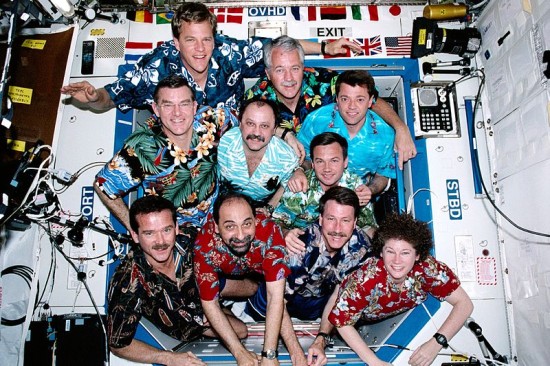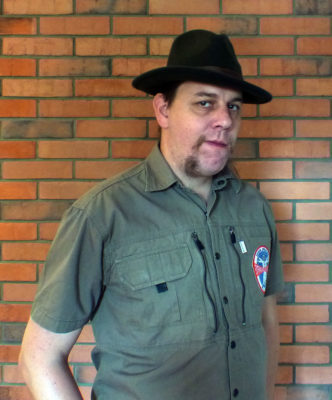Of cosmonauts and blogging
Or the top 3 tools every blogger should use
Before we take off
I am, to be honest, in no position to deem myself an expert in blogging, nor do I feel wise enough to advise others in that field, as I treat my own blogging just as a mere device to express myself and get in touch with the world. That being said and explained, I have been asked to write an article on blogging, which I believe should clarify my views on and approach to that activity.
There are many ways to blog, as many as there are bloggers. Among those some blog for fun, some blog because they need to, some blog for professional purposes, and among them some blog for freebies and advertising revenue. None of those approaches and aims are better or worse in any aspect; they are simply all different and serve various purposes.
For me, blogging is an expression of my passions and reaching out to those with similar passions and views. I have done that for over a decade now, though if someone asked me to pinpoint a specific starting point, I’d probably fail to do so, as blogging is more of a becoming process, than a specific task that could be marked on a timeline.
I have employed numerous techniques and media for my purposes, the most notable of which are writing for my personal website, which is the closest to the archetypal blog , but also using the podcast carrier to roughly do the same thing – ramble about what goes on inside my head. I started as a layman, without much knowledge whatsoever, back in the days when “writing a blog” was still assumed to be an insulting undertaking, fit for preteen girls, but that was just about to change. In the years to come blogging and bloggers turned into an opinion-creating force, lifestyle attitude makers, role models for popular culture, serving their own words and describing borrowed ideas as some kind of revealed universal truth. At least – in a way and for some of those people.
With their rising influence and a growing audience, blogs and bloggers have become of increasing interest to the business part of the worldwide information network (oh, where are those past days of referring to it as “surfing the information superhighway?), and with that rose a new generation of creative people who write, make movies, record and shoot photos. Some of those people have made a success in the field of popularity, some of them monetized their hard work, and some of them earned a badge to their brand and name, a badge of the passionate hobbyist, of the interesting strange enthusiast.
Whatever your goal is among the ones mentioned above or others – there are certain tools that all of those people seem to share. And there are approaches I myself have employed, having learned them from my own years of experiments and experience, that worked well for me. A story of these I want to share.
On how Soviets never reached the Moon

The crew of STS-74 , credit: NASA Marshall Space Flight Center
It is no longer a secret – though it was for a long time – that the Soviet Union raced the United States to the Moon and only in the knowledge of their own failure did they focus all their brilliant minds and hard work on the orbital station program known widely as Salyut. The reason for their failure, we learned in the late 1990’s, was the lack of a proper plan. And, as some sources suggest, the absence of a real need to achieve the goal. It was the US president’s challenge, cast in front of an audience, that the Americans will put a man on the face of Luna before the end of the decade. The Soviets, who have so far been winning in everything concerning the space race, had to accept the challenge. They beat the Americans with the first manned spaceflight, the first (and for almost twenty more years only) woman in space, the first multicraft flight, and finally – the first group flight. They left Americans on scorched ground, even if sometimes just by weeks or even days. And in the course of racing the hideous imperialist capitalist to the Silver Globe they achieved one more outstanding success – the first orbital docking between two manned space crafts and a successful orbital crew transfer.
So what made the Soviets fail? Why did the N1 monster rocket never leave low earth orbit and why did the Lunniy Korabl never reach the surface of our natural satellite? I believe it was because the Soviets never planned to go there in the first place. The greatest minds of that nation were involved, but the undertaking had no heart. And no real favors on the part of the Party. No passion, not fire, no feeling to take that Soviet Man, grab him with the mighty hand formed from the collective effort of the workers and scientists, and cast him into orbit like a gauntlet cast in the face of the American opponent. And most of all – no time. They were so behind their counterparts from the USA that they just couldn’t make up the lost time.
So it failed.
But it was their only failure. And the history of astronautics is full of success stories. Should you happen (which I find hard to believe) not to know the story of Colonel Chris Hadfield, a Canadian astronaut, his is one good example. The word has it that little Chris watched the man make the giant leap as a little boy. Back then, he decided to become and astronaut and follow the example of those brave, amazing people from the country south of his homeland. At that time Canada was not involved in any space activity, so little Chris grew into a big Chris and become a soldier, or to be precise – he become a fighter pilot. Note – all of those pioneers of space followed suit, on both sides of the iron curtain. Gagarin, Titov, Sheppard, Glenn, even Armstrong – all of them were fighter pilots first! And so the day has come for adult Chris Hadfield that he has been given the opportunity to fly as a Canadian beside the Americans. Fly where he always wanted – up, above the sky, above the atmosphere, into LEO. He did so not before 1995, when he was a mission specialist during the STS-74 Atlantis flight, dock in the Mir space station. He flew again onboard Endeavour six years later to finally crown a lifetime struggle for achievement in 2012, when he boarded the International Space Station and became its commander.
A lifetime of hard work, to make a dream come true.
Bear that in mind. Think of how patient and stubborn this man must have been to reach the stars, how he trained in USA, leaving his home and Canada, before he flew space shuttles. How he later moved with his family to Russia, to live in Star City, training to learn the Soyuz space craft before going into space for the final time.
Patience and endurance are the first and most important tool of trade to employ if you want to blog successfully. There is no achievement, no recognition, and no following if you are not ready to invest time and resources into what you do.
Patience and endurance, the first milestone.
I, for one, have done what I do for a decade. But my experience reaches further, gets back to the roots of what I am and what I want in life. And that is telling stories. I have told stories first, delivering spoken entertainment for my friends. Wrote stories when I was twelve, wrote stories when I was seventeen, wrote articles about the comic industry when I was thirty, and finally wrote my first novel when I was thirty-six. In a way, Chris Hadfield recording his cover of “Space oddity” is a role model for me and my own achievement. The readers of my blog know what to expect. They listen to a podcast book review on Saturday, download a space station paper model on Wednesday, read my personal rant on life and bringing up kids on Sunday. They learned the schedule during the years we have spent together. Via patience and hard work.
On the design of civilian and military orbital bases
There are as many goals of blogging as there are bloggers, but I believe I will not fail in saying that most of those who start doing anything want to succeed. There are many ways and many means to achieve success, and some are seemingly easier and some are seemingly more gratifying. In the blogging corner of the world wide web, there are many cases of people becoming famous (in a way, at least) and recognized (by some groups and in some areas) and assumed to be successful. Their way is often looked at and analyzed, taken apart to find out the key to a curious phenomenon – some of them get to the top, while the others, even though they do exactly the same thing, never leave the ground or climb the ladder just a few steps and get stuck.
One of the main reasons I believe is many of those less proficient are mere copycats. There is only one Tomczyk, but there are tons of lifestyle bloggers who think the ideas they sucked from popular culture are just as cool, while, in fact, they can never reach that level. It is, in part, due to the patience and the long path I mentioned. A new player, a challenger, can toss the gauntlet in front of an old-timer, but even if they adapt faster and know better what’s cool and what’s not, even being more sensitive to the current pulse of the online community – they lack simple experience. And anyway, there is a finite number of lifestyle bloggers that the market can take and business is ready to pay.
And here we come to what is a second, maybe even more powerful device that a blog needs. It is truth. And by that I don’t mean abandoning our online act and not making up some little story here and there. It’s more about being true to oneself. In other words – doing what you love. Because by doing what you love, you do it well. And when the audience sees the passion, the fire, the engagement – they will feel it too, they will follow. Even if that may sometimes not be their cup of tea!
Yes, there are things we fancy and thing we don’t fancy, but we know a devoted man when we see one. And a blogger wants to, needs to be perceived that way! Unless they blog for their family and a spouse. OK, scratch that. That’s as good an audience as any. And that audience, too, deserves the best.
There is nothing wrong with looking at what others did, using their tools of trade, and learning from their experience. It may as well be a lesson well learned, like the Soviet space station program teaches us. Have you ever looked into the details of the Salyut orbital bases? No? It’s a fascinating story in its own right, a breathtaking narrative with glory and death, blood, lost teeth, friendship, heroism, cunning minds, daring achievement, and most of all –full of passionate men and several women who crossed the boundaries of their own abilities. But that’s not what I wanted to say.
The Soviet Salyut space station line was, in fact, two different programs. One was a military Almaz program with OPS station design, and the other was civilian Salyut with their DOS design. The DOS was, in fact, the hull of an OPS. The original OPS was designed in the mid-1960’s by the OKB-52 secret facility lead by Chelomei. As they struggled with funding and fell behind schedule, the original design was “borrowed” by engineers from OKB-1, lead by Korolev. His people used Chelomei’s main hull and outfitted it with the engines, solar panels, and docking and transfer systems from their own space craft, Soyuz (which was, primarily, developed to fly to the Moon; once it never did, it flew to low Earth orbit in 1967 and still does so, ferrying astronauts and cosmonauts to the ISS in 2015!).
Korolev’s people used somebody else’s experience, but did their own work, and in 1971 for the first time in history they put a space base in orbit. And manned it. And it was a success.
Do your own thing and don’t look at others. The Russians competed and failed in the race to the Moon, which was not their own. But they flew six successful Salyut stations (including the only historical station that was armed with a 23mm Nudelmann cannon, used to shoot down an obsolete satellite). And then they built the Mir space complex. And nowadays the International Space Station in its very heart has the Zarya and Zvezda base blocks, forming the Russian segment.
Do your own and you will win.
Remember what I said about patience? So now take a look back at Zarya and Zvezda. The latter was supposed to be the core of the Mir-2 space station that never came to life, as the Soviet Union crumbled and was disassembled. But the failed Mir-2, the failed American space station Freedom, and the failed ESA space station Columbus all formed the ISS. It just took time. The Zvezda core module is, in fact, DOS-8, a direct descendant of the Salyut line, designed in the late 60’s and assembled in the late 80’s. It waited for years but it is up there, still, just as Zarya, a module with a long and complicated heritage. It originated as a part of a manned space vessel for the Almaz stations, called TKS. It never flew manned, but part of its design, the FGB block, was later turned into four out of six Mir modules. And into Zarya of ISS.
So if you truly love what you do, it will be good and it will serve you well. And it will be your device to win the audience. So be true to yourself and blog about what lights your own fire, not what is popular now. In two years nobody will remember the grumpy fashion blogger who felt bad about her camera on being fixed with all the attention she believed she deserved. But maybe they will look at a paper model of the Salyut 6 space station, with the Soyuz-30 model docked to it, and they will remember both Hermaszewski, who flew onboard Soyuz-30, and the humble hobbyist who designed the model.
On recording a cover of a song by a famous artist

It’s that Canadian again, and no, it’s not Matt Damon top left; credit: NASA
All of that mentioned above needs one more thing to not only succeed but to exist at all. Just as there is no writer without their readers, there is no blogger without their audience. Sure thing – writing good articles on an interesting topic is great, but it’s just sad fun if nobody reads it. So we all need to reach out to our readers.
There are many ways to gain wide recognition and many of those are good, but the most important I found over the years is being responsive. Interaction seems to be a keyword in that case. In a very wide sense. Of course it is good to engage in a banner exchange, as it will provide you exposure. But it’s worth much more when an established blogger or a website backlinks to you or even better – recommends your article. You gain some of their credibility (and some of their Google page rank as well), so it is worth creating excellent content that the branch professionals will want to recommend and further share.
But you can’t just blindly follow the rankings and ask the people from the top of some arbitrary or not-so-arbitrary influence lists to advertise your content. It works, but in a limited way. Even if it brings you up in the search results, there are ways of conduct that do more. Ask, or maybe not ask, but convince your readers to do the sharing for you. For that, you need to make friends with them. You can’t just create content and leave it hanging there, no matter how good it is. You have to discuss it, talk it over, retell it if needed, and take care of it being up-to-date. For that, you need to read what your audience wants to tell you, refer to it, mention it.
There are ways of doing it, and simple ones at that. Take care to have a good comment system like Disqus or similar – they encourage to respond. You may employ Facebook comments that provide more exposure, but I found them a bit messy. You may decide to run your blog on a social network altogether. But whatever your do, let your audience know they are important. Because they are. I write books and I write them for myself. It’s a terrific experience and a lot of fun too, but there would be no point in doing it, if not for the readers who buy and discuss the books. I need to take them under consideration – I go to conventions, meet the readers in a local library, in a bar, visit their own events, and discuss their own stories, encouraging them to write and share some of my ideas.
The same thing I do for my blog – not only do I post models and space stations, not only do I show photos of what I myself assemble out of printouts, but also ask those who build models themselves to act. I ask them to build, assess, comment, and suggest improvements. They are not only part of my network, they are part of my blogging, the beta readers, betatesters, and end-users. A blogger doesn’t need to be a figure up there, they need to be part of the crowd. Someone who has access to something more, something special. But one who shares freely.
Remember Chris Hadfield? Of course, everyone has seen “Space Oddity” played and sung onboard the ISS. Have you seen the videos he recorded for schools? Short pieces on living in space, brushing your teeth in space, and sleeping in zero gravity? Kids love them. Teachers love them. Schools do use them. This is a gift, a thank you gesture, a hand extended back. This humble man made his dream come true, he flew to the stars. But not even once did he forget the people that put him there – the engineers, designers, scientists, those before him that went into space and those who gave their life to make this dream possible. Now he helps bring up a new generation that will build better, safer, faster spaceships. That will once more reach the surface of Moon, will leave the Earth orbit and fly to Mars, to Venus. Those are years to come and the goals will take a lot of patience. But what he does is gold. He is honest, humble, and true in what he did up there and the generation that came can see that, grab that passion, can share in his activities.
Engage the same way. Pull your readers into the heart of what you create, what you have in mind, use their own OPS hulls to build your DOS. Tell them. Thank them. Praise them. Don’t flatter them or coquette them. Just show them you care. Like you would care for a friend. Turn you readers into your fans. But don’t force them. And don’t change yourself to appeal to the audience.
If you are true to yourself, even if hardly anybody cares about what you are doing now, if you wait – they will. Those who don’t care will go away. Some of them might start to care. They might even learn they like it and they will remember who brought them in, who showed them a new, great world. And they will be happier than ever if they see their names and their ideas incorporated (and credited!) in what you do. Make them part of your own experience, let them share the success.
Reach out for them, search the analytics, see where they come from, who they are, how they talk, what makes them tick. Choose what you have to offer and follow them. Let yourself go with the flow.
This is what blogging is all about – do something great.
On how we might one day go to Mars
The Red Planet is a target that has been aimed at for decades. Both Soviet (later Russian) and American designers looked at the sky and planned. Valeri Polyakov spent almost 438 days during a single long-term mission onboard the Mir space station to test the ability of humans to thrive in space for long periods of time. It was twenty years ago. The experiments he carried out, the research and all scientific data are still patiently waiting. They are evaluated, researched, re-read again and again, as people near the day they will launch a manned space craft toward Mars, the Moon, or the cislunar orbit.
I am sure everyone wants to reach the top quickly. It’s only natural to want to be gratified for one’s hard work. There nothing wrong with that. But the best tools, software and analytics won’t bring success. You may be a perfect copy of a great blog, act the same way, frequent the same social networks, and even have you pics taken on a wall with all the important influencers. But that can’t be done fast. What comes fast may just as quickly vanish, fade away below the event horizon. You may do the same things, but be just a mere copycat if what you are dealing with is not in your heart. And people’s mercy is whimsical. They may come if you take up a popular topic, but leave if you don’t offer them anything special, anything they can’t get some other place, anything personal.
Take time, blog about what you know and love, let your audience in. These are my tools of trade. This is my mission statement. I may not set my foot in the gray lunar dust. But, just like Lovell, Swigert and Haise I should try my best. This is what I owe all the people who look at me and might sometimes think I’m different. I am not, I’m one of them, just a guy who had enough spare time to reach out and share.
Don’t be the Soviets and the Americans of the space race era, trying to best your opponent in gaining more recognition, more likes, more click-throughs. Be that humble Canadian who lived his dream and let everyone dream it too.
Deorbit burn
As a few last words I would like to thank those people, who made writing this piece possible at all. First of all Mick, who asked me to do it. Kacper, who is a marketing specialist so above my lever but shares the core of my views and ensured me the path I choose is a good one. Krzysztof, who helped me edit this paper and make it better. And the little boy back at home for whom I assemble the paper space station models.










Tu tradycyjna kontrola czepialstwa. Czemu piszesz Tomczyk a nie J A S O N H U N T autor KSIĄŻKI. No i weź, prosisz o opinię a niby w jakim języku? To ja już wolę zniknąć po angielsku.
To już bym raczej napisał „Kominek”.